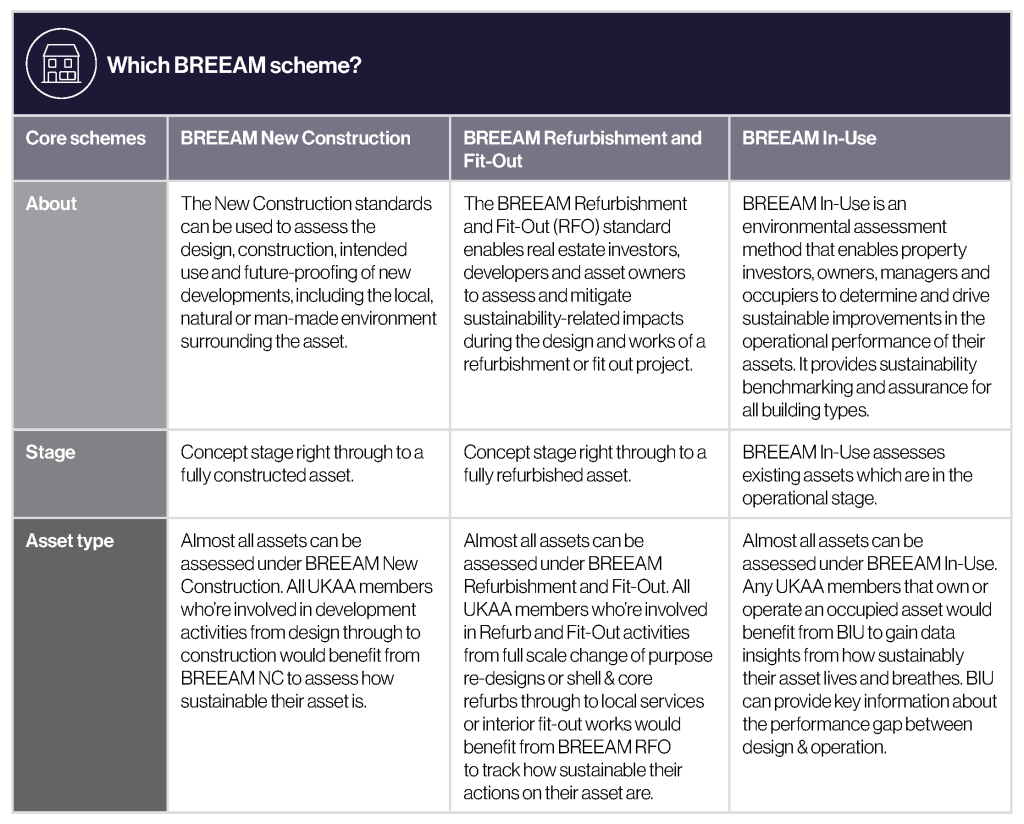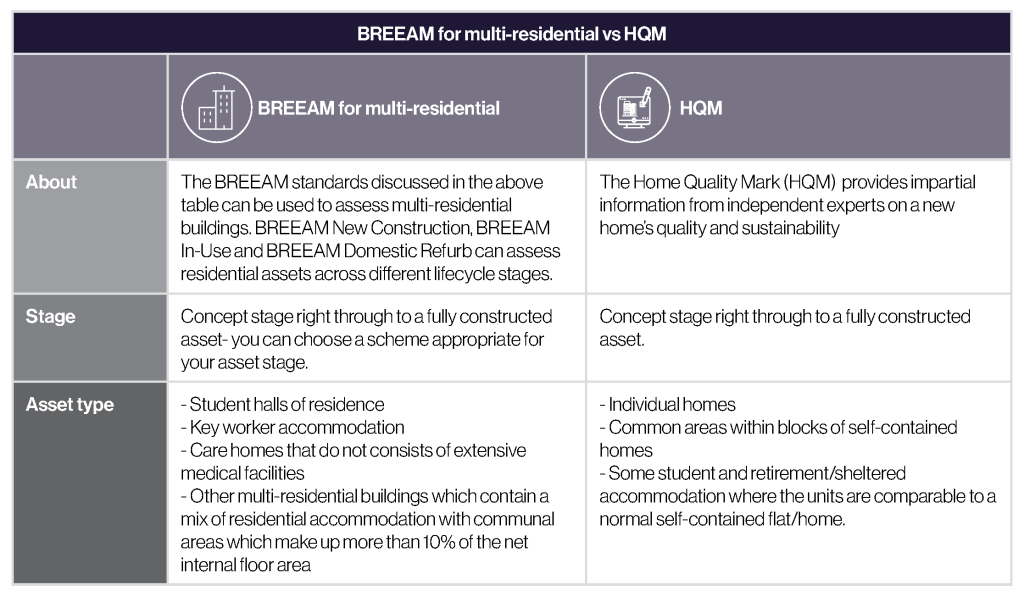BRE, the independent and impartial research-based advisory, testing and training organisation, has been raising the standards of the built environment since 1921 through independent research and knowledge sharing.
This is used to create products, standards and qualifications to make buildings, homes and communities safer, more efficient, productive, sustainable and enjoyable places to be.
One of BRE’s flagship products is BREEAM, the Building Research Establishment Environmental Assessment Method. It is the world’s leading science-based suite of validation and certification systems for the sustainable built environment.
Those working in the Build to Rent (BTR) and private-rented (PRS) sectors understand the importance of measuring, benchmarking, and achieving positive environmental, social and governance (ESG) outcomes.
When it comes to achieving these outcomes, BREEAM is a powerful tool. Here’s how our certification schemes can benefit the BTR sector.

You can find a suitable BREEAM scheme for your project
Which BREEAM scheme?
Home Quality Mark (HQM) v using BREEAM schemes to assess multi-residential assets
HQM and BREEAM certifications are both relevant to the BTR sector. Here we outline the differences, to allow you to decide which scheme is most relevant to your project.

Home Quality Mark (HQM) or BREEAM?
HQM
HQM has been designed with the occupant in mind. It assesses individual homes and accounts for common areas associated with blocks of self-contained homes. HQM outputs are specifically aimed at those living in the home and are designed to better inform the occupant about the benefits of the home that they are purchasing or renting.
An HQM project will meet one or more of the following criteria:
- Be designed to meet the function of a long-term, self-contained home even though there may be some provision of communal facilities which can be used on a voluntary basis
- Be classified under Building Regulations Part L1a (required to complete SAP assessments, although there may be some linked SBEM assessed spaces associated with the project)
- As such, HQM projects could be homes for sale, social housing, or homes for rent (PRS and Built to Rent). They may also include some student and retirement/sheltered accommodation where the units are comparable to a normal self-contained flat/home.
Using BREEAM to assess multi-residential assets
For the purpose of using BREEAM to assess multi-residential assessments, the term ‘multi-residential’ is used in the context of buildings that contain rooms for residential purposes alongside communal facilities for catering, leisure, care etc.
This scheme usually covers more student halls of residence, residential care homes, short-term rentals and co-living. The scheme can cater for a small number of self-contained dwellings where these form part of a larger multi-residential development.
Under this scheme, the project is assessed on a whole-building basis and does not seek to reflect the performance of individual residential units/rooms.
A BREEAM multi-residential project will meet one or more of the following criteria:
- Be provided for transient /non-permanent occupants
- Provide suitable accommodation for occupants requiring support from carers, wardens or similar
- Include shared living spaces
- Be classified under Building Regulations Part L2a
Ultimately, the determining factor for a scheme classification is focused on the intent of the building and who is going to be the end user. Broadly, if the building’s main purpose is for long-term homes, the Home Quality Mark is the correct scheme to use.
BRE advise that the BREEAM sustainability framework is embedded into the project from the preparation and brief stages of design
Tips for successful BREEAM/HQM process
Timing is key to a successful certification process.
BRE advise that the BREEAM sustainability framework is embedded into the project from the preparation and brief stages of design.
This allows sustainable solutions to be designed into the project, rather than considered retrospectively, ensuring the most value from sustainable outcomes, and avoiding later cost and process implications.
In addition, there are several mandatory criteria that must be achieved by certain design stages; if the implementation of the BREEAM framework is delayed and, as a result, these timeframes are missed, the projects risks restricting its overall rating.
A BREEAM/HQM assessor understands the process and technical issues covered by the scheme for which they must be qualified and licensed.
Their role is to interpret the requirements of each issue in relation to a project, communicate these requirements to their client and liaise with the project team to collate the evidence which needs to be submitted along with the assessment report.
BRE’s GreenBookLive tool can help you find the right assessor for your project. A BREEAM advisory professional could also be bought on board to inform, guide and facilitate teams throughout the life of the project, assisting design and construction teams in their individual and collective decision-making and evidence preparation throughout.
Question your assessor about the following areas:
- Experience
- Track Record
- Previous Projects
- Cost
BREEAM considers and encourages practices that support the asset (and its users) throughout its lifecycle journey
Benefits of BREEAM and HQM certifications for Build to Rent providers
The benefits of BREEAM for the BTR/PRS industry range from finance, data, investment, property management and, of course, to encouraging and proving positive sustainable procedures.
Holistic view: BRE’s view on sustainability is holistic and considers the occupants of the buildings and how the building performs as an isolated asset, including building resilience, transport links and operational procedures that have a positive effect on ESG.
Tenant relationships: BREEAM allows asset managers to approach tenant relationships by implementing a holistic management system that integrates both the social and environmental aspects of ESG. It also provides a wealth of data from certification which continues to work for the investor/operator after the certification, to provide key data insights or to drive intelligent investment decisions. BREEAM also considers and encourages practices that support the asset (and its users) throughout its lifecycle journey.
Proven increased rent: Finally, BREEAM & HQM have been proven to provide ROI from multiple areas and not just by creating a more operationally efficient building. For example, a 2021 study by Knight Frank found a positive and significant impact of Very Good, Excellent and Outstanding BREEAM In-Use ratings – ranging from 3.7% to 12.3% premiums. ESG is so intrinsically linked with finance, BREEAM & HQM have been key to unlocking green bonds and investment for the UK Real Estate industry.
Strong values: The certification provides an independent way of communicating sustainability claims to renters and occupiers. It provides independent verification that the asset is high-quality and designed with occupant wellbeing in mind. As we know, the BTR’s target market is more sustainability conscious, and they are willing to pay for this. BREEAM’s certification and data provides a wealth of marketing advantages to prove this independently to your future renters and occupiers.
Future Developments at BRE
In the pipeline is a new BREEAM Platform which will streamline the certification processes, deliver evidence and data-driven insights, responding to the needs of the market on key topics like net zero, ESG reporting, and biodiversity.
The platform is founded on third-party verified data to ensure that insights across all assets and portfolios empower you to take real action. You will be able to make tangible positive change and demonstrate compliance with international policy goals, improve asset performance, and reduce their impact on the planet.